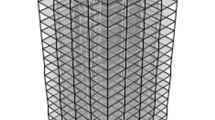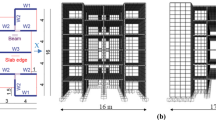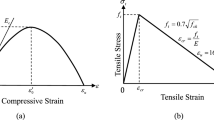Abstract
This paper presents an experimental study of the seismic response of a 0.6-scale three-story seismicresistant building structure consisting of a moment resisting frame (MRF) with reduced beam sections (RBS), and a frame with nonlinear viscous dampers and associated bracing (called the DBF). The emphasis is on assessing the seismic performance for the design basis earthquake (DBE) and maximum considered earthquake (MCE). Three MRF designs were studied, with the MRF designed for 100%, 75%, and 60%, respectively, of the required base shear design strength determined according to ASCE 7-10. The DBF with nonlinear viscous dampers was designed to control the lateral drift demands. Earthquake simulations using ensembles of DBE and MCE ground motions were conducted using the real-time hybrid simulation method. The results show the drift demand and damage that occurs in the MRF under seismic loading. Overall, the results show that a high level of seismic performance can be achieved under DBE and MCE ground motions, even for a building structure designed for as little as 60% of the base shear design strength required by ASCE 7-10 for a structure without dampers.
Similar content being viewed by others
References
ASCE. Seismic rehabilitation of existing buildings (ASCE/SEI 41–06). American Society of Civil Engineers, Reston, VA, 2007
BSSC. NEHRP recommended seismic provisions for new buildings and other structures (FEMA P-750 2009 Edition). Federal Emergency Management Agency, Washington, D C, 2009
ASCE. Minimum design loads for buildings and other structures (ASCE/SEI 7–10). American Society of Civil Engineers, Reston, VA, 2010
Constantinou M C, Symans M D. Experimental and analytical investigation of seismic response of structures with supplemental fluid viscous dampers. NCEER Rep. No.92-0032, State University of New York at Buffalo, N Y, 1992
Reinhorn A M, Li C, Constantinou M C. Experimental and analytical investigation of seismic retrofit of structures with supplemental damping. Part i: Fluid viscous damping devices. Technical Rep. No. NCEER-95–0001, National Center for Earthquake Engineering Research, State Univ. of New York at Buffalo, Buffalo, N Y, 1995
Seleemah A, Constantinou M C. Investigation of seismic response of buildings with linear and nonlinear fluid viscous dampers. Report No. NCEER 97–0004, National Center for Earthquake Engineering Research, State Univ. of New York at Buffalo, Buffalo, N Y, 1997
Whittaker A S, Constantinou M C, Ramirez O M, Johnson M W, Chrysostomou C Z. Equivalent lateral force and modal analysis procedures of the 2000 NEHRP provisions for buildings with damping systems. Earthquake Spectra, 2003, 19(4): 959–980
Charney F A, McNamara R J. A comparison of methods for computing equivalent viscous damping ratios of structures with added viscous damping. Journal of Structural Engineering, 2008, 134(1): 32–44
Takewaki I, Yoshitomi S. Effects of support stiffness on optimal damper placement for a planar building frame. Structural Design of Tall Buildings, 1998, 7(4): 323–336
Singh M P, Moreschi L M. Optimal placement of dampers for passive response control. Earthquake Engineering & Structural Dynamics, 2002, 31(4): 955–976
Wongprasert N, SymansMD. Application of a genetic algorithm for optimal damper distribution within the nonlinear seismic benchmark building. Journal of Engineering Mechanics, 2004, 130(4): 401–406
Chen Y T, Chai Y H. Effects of brace stiffness on performance of structures with supplemental Maxwell model–based brace–damper systems. Earthquake Engineering & Structural Dynamics, 2011, 40(1): 75–92
Pekcan G, Mander J B, Chen S S. Fundamental considerations for the design of nonlinear viscous dampers. Earthquake Engineering & Structural Dynamics, 1999, 28(11): 1405–1425
Terenzi G. Dynamics of SDOF systems with nonlinear viscous damping. Journal of Engineering Mechanics, 1999, 125(8): 956–963
Lin W, Chopra A. Earthquake response of elastic single-degree-offreedom systems with nonlinear viscoelastic dampers. Journal of Engineering Mechanics, 2003, 129(6): 597–606
Sorace S, Terenzi G. Seismic protection of frame structures by fluid viscous damped braces. Journal of Structural Engineering, 2008, 134(1): 45–55
AISC. Specification for Structural Steel Buildings (ANSI/AISC 360–10). American Institute of Steel Construction, Chicago, Illinois, 2010
AISC. Seismic Provisions for Structural Steel Buildings (ANSI/ AISC 341–10). American Institute of Steel Construction, Chicago, Illinois, 2010
AISC. Prequalified connections for special and intermediate steel moment frames for seismic applications (ANSI/AISC 358–10). American Institute of Steel Construction Inc, Chicago, Illinois, 2010
Dong B. Large-scale experimental, numerical, and design studies of steel MRF structures with nonlinear viscous dampers under seismic loading. Dissertation for the Doctoral Degree. Bethlehem, PA: Lehigh University, 2015
Chopra A K. Dynamics of Structures: Theory and Applications to Earthquake Engineering. 4th ed. Prentice Hall: New Jersey, 2011
Sause R, Hemingway G J, Kasai K. Simplified seismic response analysis of viscoelasticdamped frame structures. Proceedings of the 5th U.S. National Conference on Earthquake Engineering, 1994, I: 839–848
Dong B, Sause R, Ricles J M. Accurate real-time hybrid earthquake simulations on large-scale MDOF steel structure with nonlinear viscous dampers. Earthquake Engineering and Structural Dynamics, 2016, 44(12): 2035–2055
PEER NGA. Pacific Engineering Research Database. 2008 (http:// peer.berkeley.edu/nga)
Galambos T V, Ellingwood B. Serviceability limit states: deflection. Journal of Structural Engineering, 1986, 112(1): 67–84
Ellingwood B R. Earthquake risk assessment of building structures. Reliability Engineering & System Safety, 2001, 74(3): 251–262
McCormick J, Aburano H, Ikenaga M, Nakashima M. Permissible residual deformation levels for building structures considering both safety and human elements. In: Proceedings of the 14th World Conference on Earthquake Engineering. 2008
Engelhardt M D, Winneberger T, Zekany A J, Potyraj T J. Experimental investigation of dogbone moment connections. Engineering Journal, 1998, 35(4): 128–139
Chi B, Uang C M. Cyclic response and design recommendations of reduced beam section moment connections with deep columns. Journal of Structural Engineering, 2002, 128(4): 464–473
Zhang X, Ricles J M. Experimental evaluation of reduced beam section connections to deep columns. Journal of Structural Engineering, 2006, 132(3): 346–357
Lignos D G, Kolios D, Miranda E. Fragility assessment of reduced beam section moment connections. Journal of Structural Engineering, 2010, 136(9): 1140–1150
Lignos D G, Krawinkler H. Deterioration modeling of steel components in support of collapse prediction of steel moment frames under earthquake loading. Journal of Structural Engineering, 2011, 137(11): 1291–1302
Author information
Authors and Affiliations
Corresponding author
Rights and permissions
About this article
Cite this article
Dong, B., Ricles, J.M. & Sause, R. Seismic performance of steel MRF building with nonlinear viscous dampers. Front. Struct. Civ. Eng. 10, 254–271 (2016). https://doi.org/10.1007/s11709-016-0348-8
Received:
Accepted:
Published:
Issue Date:
DOI: https://doi.org/10.1007/s11709-016-0348-8




